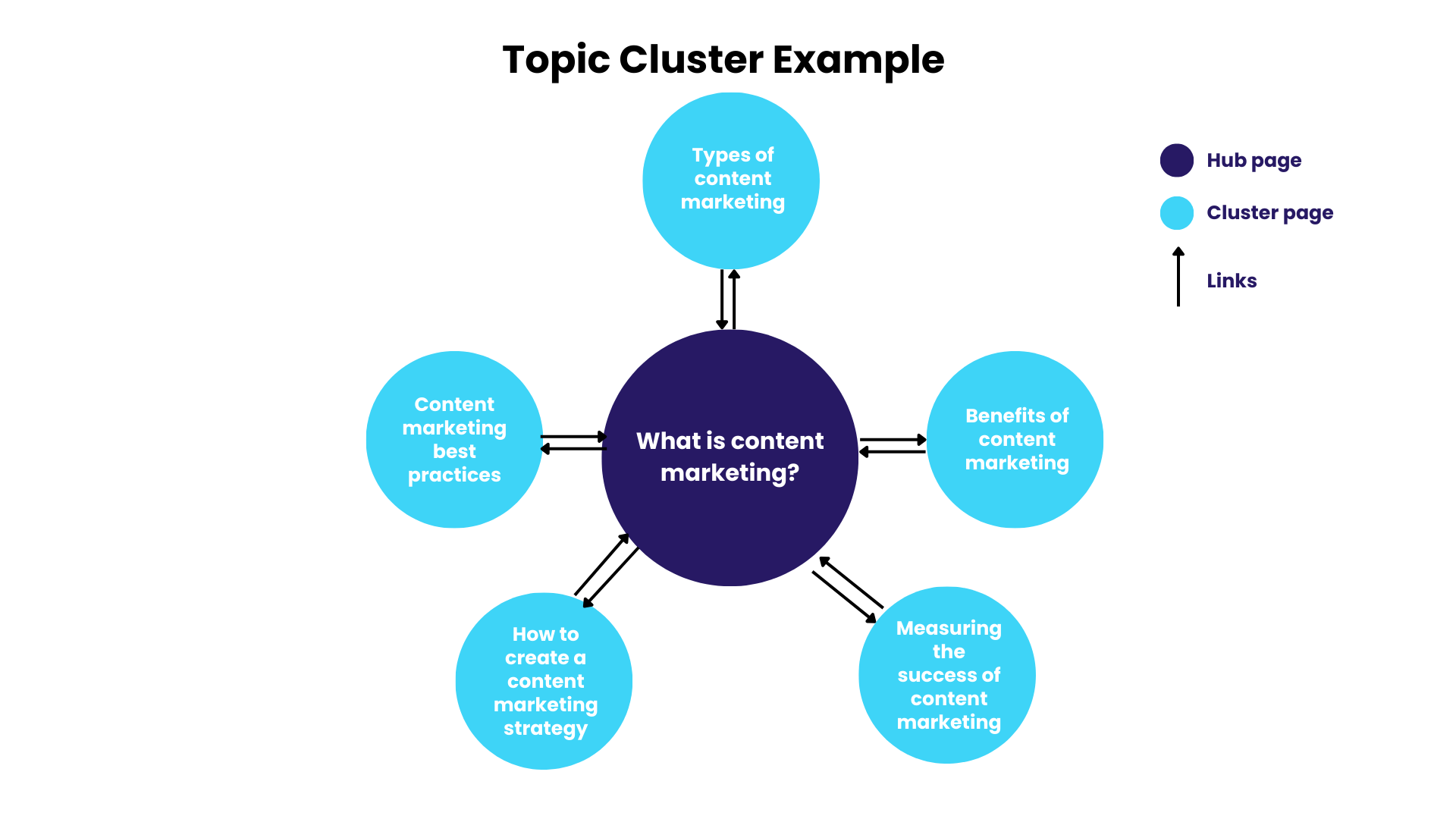Search engines like Google have undergone a transformation in how they process content. Gone are the days of relying solely on simple keywords; instead, they now employ more complex techniques that integrate Natural Language Processing, NLP, and select terms to identify well-organized, meaningful, and interconnected content.
While search engines have become adept at discerning a content’s purpose and target audience, as a website owner, it’s always advantageous to retain control over your narrative. Enter topic clusters.
Topic clusters empower you to categorize related subjects into distinct containers. This strategic approach not only makes it easier for search engines to comprehend the essence of your website but it also enhances your chances of achieving faster and higher rankings when executed effectively.
In this article, we will delve into the concept of topic clusters and a comprehensive, step-by-step guide on crafting these clusters to optimize your online presence.
Topic Clusters 101
A topic cluster is a method of organizing content in a more user-friendly and search-engine-friendly manner.
Think of your website as a well-curated library. Here, you wouldn’t want to scatter books randomly. Instead, you aim to group related books, creating an easier path for readers to find and explore related topics. Topic clusters work on a similar principle for your online content, grouping interrelated pieces around a central theme or topic.
The cornerstone of this strategy is the pillar post, a comprehensive piece of content that covers a core topic in depth. Surrounding this pillar post are numerous related subtopics or cluster content. They delve into specific aspects of the core topic, providing detailed insights and linking back to the pillar post.
Examples of topic clusters
The concept of topic clusters is better understood with tangible examples. There are numerous instances where websites have leveraged the power of topic clusters to create a coherent content structure, thereby enhancing their digital footprint.

A noteworthy case study, featured on Minuttia’s website, describes how they implemented a topic cluster strategy for the referral marketing platform Viral Loops. Their main objective was to gain visibility for the topic “product launch” and its associated subtopics. Notably, there was no active promotion, such as link building, involved in the project; they relied solely on the cluster’s content quality and structure.
The project was a success for Viral Loops. The topic cluster ranked for more than 1.1k organic keywords when the case study was published. Additionally, many cluster posts ranked well for their intended keywords.
Hootsuite’s content marketing strategy is another example of the power of topic clusters in action. Their complete guide to Facebook Marketing in 2023 serves as a central pillar post. This extensive post not only provides comprehensive information but also strategically integrates over 25 internal links to related Facebook content they’ve created.
What makes this approach particularly effective is the quality of Hootsuite’s content within each cluster piece. Each article stands on its own as valuable, authoritative content. This not only enhances the user experience but also contributes to the independent ranking of each piece within the cluster.
These examples underscore the potential of topic clusters. It is evident that the strategic use of topic clusters can be a game-changer in content marketing, helping brands establish authority and relevance in their niches.
Topic clusters and their role in technical SEO
Search engines are always on the lookout for content that’s valuable to users (think Helpful Content Update). Technical SEO strategies are implemented in order to ensure that search engines can easily find, understand, and index content on a website. Topic clusters streamline this process.
The arrangement of related topics in a cluster helps search engines decipher the structure of a website. Some ways in which topic clusters impact technical SEO include:
Improved site authority
The more organized your content, the easier it is for search engines to crawl and index. A topic cluster model ensures that the authority from your pillar post trickles down to your cluster content, helping these subtopic pages rank better and encouraging visitors to come back to find reliable, quality content.
Contextual understanding
When your main pillar post links to various subtopics, search engines can easily see how all these pieces fit together. This interconnected web of content gives search engines a clearer picture of the depth and breadth of your website’s knowledge on a particular subject.
Improved user experience
An effective topic cluster ensures your readers can navigate easily from a broad topic to its specific facets without getting lost. By implementing breadcrumbs, clear navigation paths, and interlinked content, the user experience is enhanced, leading to longer site visits.
Decreased bounce rate
With longer visits come reduced bounce rates. Content developed around topic clusters help users find related content more quickly and consequently they tend not to return to the SERPs to find related content. Reduced bounce rate is a factor that search engines take into account when ranking pages.
Enhanced organic visibility
When you categorize content into relevant clusters, it increases the chances of multiple pages appearing in search results for similar queries.
For instance, someone searching for ‘Fitness tips for beginners’ might land on your pillar post, while another query like ‘best workouts for body types’ could lead them to one of your cluster content pieces.
An idea mill and more
While the SEO advantages of topic clusters are often what many experts focus on, there’s an underlying value that sometimes takes a backseat but is undeniably significant: the tremendous capacity to harness the depths of an idea.
Every topic, no matter how narrow it might seem at first glance, holds a universe of ideas within it. By adopting the topic cluster model, content creators are nudged to dive deeper, to uncover and present every nuance, every facet of a subject.
Imagine you’re trying to learn Italian cooking. Would you prefer a website that has just one generic article on it, or a site with an expansive collection covering everything from basic pasta recipes to intricate risottos and regional specialties? The latter, undoubtedly!
Over time, this comprehensive approach ensures that the site becomes the first port of call for anyone eager to learn about the topic. In other words, it transitions from being just another source of information to the go-to resource.
Anatomy of a topic cluster
Topic clusters comprise three essential components: a pillar post, cluster content, and internal links. Understanding these components is the first step to improving your website’s visibility and authority.
Pillar post
A pillar post is a comprehensive, in-depth article that covers a core topic exhaustively. Unlike regular blog posts, which may touch upon a subject briefly, pillar posts delve deep, offering readers a holistic view of the subject. They are typically longer, well-researched, and serve as the anchor around which related subtopic content revolves.
Pillar posts are so important for a number of reasons:
- They form the foundation upon which related subtopics are built. Think of it as the trunk of a tree, with the subtopics being the branches.
- Owing to their comprehensive nature, pillar posts are often packed with valuable keywords and information, making them highly favored by search engines.
- A well-researched and well-written pillar post can showcase your expertise in your niche, setting you apart from competitors.
Cluster posts
A cluster post focuses on a specific subtopic related to the overarching subject of the pillar post.
For instance, if your pillar post is about digital marketing, a cluster post might dive deep into email marketing strategies or the role of SEO in digital marketing.
These cluster posts serve multiple purposes:
- They offer readers an in-depth exploration, allowing for a thorough understanding of each aspect of the main topic.
- Each one often features targeted analyses, insightful case studies, or the latest research results related to its subtopic, making them invaluable resources for readers looking for detailed information.
- With each cluster post targeting specific keywords related to its subtopic, the chances of ranking higher for a range of queries or long-tail keywords associated with the main topic increase.
Internal links
At a basic level, internal links connect one page of a website to a different page on the same site. In the framework of a topic cluster, they are the threads that weave individual pieces of content together, creating a cohesive tapestry of related information.
They guide users, allowing them to journey seamlessly from a general topic (pillar post) to more specific subtopics (cluster posts) and back again.
Internal links in a topic cluster are pivotal because:
- They clarify the relationship and connectivity between main and subtopics in a cluster.
- Strategically placed internal links foster a guided, educational user journey from basic to advanced insights within your website’s content ecosystem.
- Internal links aid search engines in understanding page relevance, hierarchy, and authority.
Creating a topic cluster
Are you ready to enhance your content strategy with topic clusters? In this section, I’ll walk you through the process of creating your own topic cluster so you can harness their full potential to improve SEO and user engagement.
Start with a general topic idea
When embarking on the journey of creating a topic cluster, the starting point is often a broad or general topic idea. This idea serves as the foundation upon which all related subtopics are built. But why focus on a general topic idea, and how can it captivate a wider audience?
General topics usually resonate with a broad spectrum of readers. While the overarching topic is general, it provides an opportunity to delve deeper into specific areas of the topic. This gives you the latitude to explore niche areas within the general framework.
Let’s say, for example, you’re just getting started in the SEO industry. The first thing you’ll probably research is a guide to technical SEO for beginners. The general article will touch on a number of SEO subjects to give you an overview without delving into any one subject in depth.
Keyword research tools are an important part of this process. They can be helpful in gauging the popularity and interest in a general topic idea. Additionally, they offer insights into the competition, helping content creators understand the saturation level of the topic in the digital landscape.
A general topic idea isn’t just about casting a wide net; it’s about finding a balance. The right general topic allows for a blend of wide-reaching appeal and the depth of specialized content. As you continue with the process of topic cluster creation, this foundational general topic will be your anchor, around which all other related content gravitates.
[Ebook] Technical SEO for non-technical thinkers
Create sub-topics
Within the structure of a topic cluster, while the general topic lays the groundwork, it’s the sub-topics that add depth and breadth. Sub-topics are your opportunity to hone in on specific issues or questions that readers may have concerning the general topic.
The success of sub-topics largely depends on how well they align with what your audience is searching for. Crafting sub-topics requires a meticulous approach to match the content with various search queries that potential readers might use. When users find content that precisely matches their search intent, they’re more likely to engage with it, spend more time on the site, and even become recurring visitors.
Craft well-researched and helpful content
In creating a robust topic cluster, the framework and strategy are crucial. Yet, the heart and soul of any cluster remain the quality and depth of the content itself. Today’s readers are discerning; they come to your site seeking answers, and they can quickly distinguish between hastily put-together content and in-depth, well-researched pieces.
Moreover, Google’s recent Helpful Content Update (HCU) places an even greater emphasis on content quality. This significant algorithmic shift seeks to accentuate content that genuinely offers valuable and constructive information to its users.
The endeavor to create well-researched and helpful content is an investment in building a strong, authoritative, and user-friendly topic cluster. It lays a foundation of trust and encourages readers to return, explore, and engage.
Link related articles to one another and to the pillar page
Every article plays a part in a topic cluster. A well-linked topic cluster establishes your website’s authority on the entire topic. It signifies that you’re not just touching upon different aspects sporadically but offering a comprehensive, interconnected understanding of the subject.
For effective interlinking, keep these tips in mind:
- Ensure links are placed in a contextually relevant manner. This ensures that the transition feels natural and adds value to the reader.
- Avoid excessive linking in a single article, especially to topics that are not within the silo. Overdoing this can defeat the purpose of creating clusters.
- Use anchor texts that clearly indicate what the linked article is about.
- Ensure a balanced distribution of links to create a cohesive content ecosystem.
- Make sure all internal links point to live web pages.
Regularly update and expand
As with any significant piece of literature or reference, your topic cluster will require regular updates to stay current and relevant. Regularly reviewing your content can boost your chances of maintaining or even climbing higher in search rankings.
Furthermore, as you expand your cluster with more subtopics, you diversify the range of keywords for which you rank, further increasing your online visibility.
A note of caution: When you’re dealing with a topic that has a vast amount of supporting content, it can be tempting to include every detail in the pillar post. However, this can be counterproductive. Instead, focus on presenting the essential information that provides a solid foundation and overview of the topic.
Optimize for SEO
Through adept SEO practices, your carefully crafted content can gain the recognition it deserves and consequently draw in more readers.
In this guide, we’ve explored various SEO strategies. Now, let’s summarize the essential SEO techniques you can implement:
- Identify core keywords related to your central topic.
- Utilize long-tail keywords for subtopics to capture diverse queries.
- Make use of keyword research tools to find opportunities and assess competition.
- Incorporate the identified keywords naturally within your content.
- Use compelling meta descriptions and title tags to capture user attention.
- Ensure that your content is structured well with clear headings and subheadings for easier navigation.
- Create high-quality, shareable content that naturally attracts backlinks.
Essential tools for creating topic clusters
As you set out to create topic clusters, it’s vital to equip yourself with tools that streamline the process and enhance the outcomes. Here’s a list (by no means exhaustive) of tools you may find useful.
Ahrefs: Offers insight into potential topic areas with its Content Gap and Keyword Explorer tools. By understanding what competitors are focusing on, you can curate more comprehensive topic clusters.
BrightEdge: The SEO software offers the Data Cube module that reveals the full set of keywords for which your current content ranks, as well as those keywords that your competitors are ranking for. You can also use their Recommendations section to refine your choice keywords into smaller groups of high-value keywords.
SEMrush: SEMrush’s Topic Research tool helps you unearth new topic ideas. It also aids in gauging audience interest and strategizing a content plan structured around clusters.
HubSpot’s Content Strategy Tool: Built especially for topic clusters, this tool identifies main topics and their related subtopics. It arranges them neatly into clusters and also tracks how they perform.
AnswerThePublic: This tool transforms simple keyword inputs into a visual landscape of related queries and concerns. By presenting what the public is searching for in relation to a topic, it proves useful for those seeking to expand upon or refine their content direction.
Google’s “People Also Ask” Section: Often overlooked, the “People Also Ask” segment in Google search results can unveil related subtopics or frequently asked questions, offering a more rounded view of your primary topic.
Link Whisper: An AI-driven WordPress plugin, Link Whisper suggests relevant internal links as you write or edit your content. It’s a powerful tool to maintain a strong internal link structure.
Yoast SEO Premium: Apart from its SEO suggestions, the premium version of this popular WordPress plugin provides insights for internal linking opportunities, ensuring different articles within topic clusters are efficiently interconnected.
Final thoughts
In the ever-evolving landscape of digital content, the way we organize and present our content can have a great impact on its success. Topic clusters represent a forward-thinking approach to content creation, marrying the depth of content with the clarity of structure.
As uncovered in this article, creating a topic cluster isn’t merely about writing several articles around a theme. It’s about weaving these pieces into a cohesive and interconnected tapestry, all guided by a strong pillar post.
Embrace the topic cluster methodology, and watch your content soar. Keep in mind, in today’s digital age, it’s not just about what you say, but also how you structure it.

